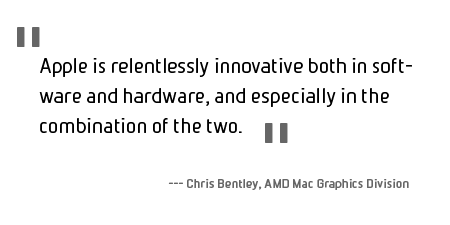As part of this special series we have had the pleasure of speaking to the CAD and 3D industries’ brightest leaders on the software side of the fence. Now we turn our attention to a critical leader on the hardware side: Chris Bentley, the division team leader of Macintosh graphics at AMD.
Advertisement
In the past Chris has spoken to Architosh about the detailed relationship between Apple hardware engineering and AMD/ATi, and the various details that shape the decision-making process in hardware design and the resultant performance realities for users. Our “state of the union” style series wouldn’t be complete without a serious fireside chat with Chris Bentley. He has been on the extreme inside tract of Apple’s Mac hardware engineering like no other outside Apple for many years.
So let’s get in real close and talk about Mac graphics!
AFR: (Anthony Frausto-Robledo): In your role you are on the inside track of hardware development. Can you describe to me briefly the importance AMD/ATi plays in supporting Apple’s Mac graphics hardware advances? To what degree is AMD/ATi an influence on Apple’s decisions?
CB: (Chris Bentley): Apple is relentlessly innovative both in software and hardware, and especially in the combination of the two. I looked back over the interview we did in January 2007; apart from being a good read, I am struck by the fact that it came out just on the cusp of Apple introducing the first iPhone. Since then Apple has shipped multiple generations of the iPhone, the iPod Touch, the iPad, the iPad 2, the MacBook Air, and numerous laptop and desktop systems. All of these devices are powered by OpenGL or OpenGL ES graphics. I think it’s fairly well accepted that Apple has shipped more OpenGL accelerated devices than any one else on the planet.
AMD works closely with Apple on both the software and hardware sides. The software we write for Apple is entirely customized for Mac OS X. Since 2007 we have added support for the Radeon HD 2xxx, 3xxx, 4xxx, 5xxx, 6xxx chip families, and added support for OpenGL 3.0, 3.1, 3.2, encompassing over 30 new features and extensions, as well as OpenCL 1.0, 1.1, and hardware accelerated H.264 decode support in Lion. Delivering OpenGL 3.2 and the other features in Lion required Apple and AMD engineers to work hand-in-glove for months. On the hardware side, Apple receives regular presentations on our hardware roadmap, and for every Apple program using AMD GPUs, our hardware engineers work closely with Apple throughout the bringup and production phases.
So, I would say that we are deeply invested in supporting Apple’s innovation in graphics software and hardware. I think the relationship is more about working together, and less about our influencing them.
AFR: For years many Mac pros have lamented the lack of GPU options and specific pro-level cards. But over the past several years Apple has done much better. What do you feel are some of the decisive factors affecting Apple’s decisions in what GPU cards to support? And how much better would you describe the situation today than say seven or ten years ago?
next page: Pro Apps and OpenGL Performance





Reader Comments
Comments for this story are closed